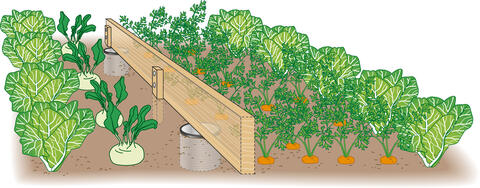Using Traps to Control Mole Crickets
Mole crickets often devastate vegetable garden seedbeds as a result of their burrowing. But there are good ways to keep the pests at bay.

The scientific name for Mole crickets is Gryllotalpa
Mole crickets are primeval looking relatives of the locust. They are up to 2.75 inches long and, like moles and voles, they spend most of their lives underground. As Mole crickets prefer loose, cultivated soil, they are often found in vegetable gardens and compost heaps. Their tunnel systems can become quite big over time – the nocturnal creatures construct new tunnel systems every day with an overall length of more than 100 feet. The approximately two-inch wide tunnels usually run just below the ground surface, but some lead almost vertically down to deeper cavities for feeding and mating.
Mole crickets feed almost exclusively on grubs, worms, and other soil insects. They occasionally eat plant roots, but only when food is scarce. However, they regularly destroy new vegetable patches by pushing young seedlings out of the ground with their digging. Dead patches on lawns, about the size of a tennis ball or volleyball, often indicate the presence of mole crickets. The insects’ nesting cavities are located under these patches. As they bite through all the roots when creating these cavities, the plants in these spots dry out.
Mole crickets can become pests locally: there have been instances where 7000 of the creatures were caught in 6500 square feet of park lawns. There are different types of mole cricket found in different regions of the United States. There are also upsides to the creatures: their diet includes snail eggs and grubs. For this reason, you should only take action against mole crickets if the damage is extensive.
One environmentally friendly method of control is to encourage natural enemies of the crickets. This includes, among others, hedgehogs, shrews, moles, cats, chickens, and blackbirds. You can also take direct action against the insects with parasitic nematodes: So called nematodes (Steinernema carpocapsae) can be ordered from specialist retailers and are applied in June/July by adding them to a watering can of lukewarm tap water that has been left to stand for a while. They mainly kill the adults insects and are less effective against their larvae.
For serious infestations, you should dig up and destroy all nests from June onwards. Use your finger or a small stick to feel the tunnels. When they suddenly branch off downwards, the nesting cavities are nearby.

Mole crickets can be caught alive using a special trap structure. Dig two containers with smooth walls (mason jars or large tin cans) into the vegetable patch or lawn at ground level and put a thin wooden board on its long edge on the middle of the container openings. The nocturnal Mole crickets usually only venture to the surface under the cover of darkness and, like many small creatures, they tend to move along elongated obstacles, as they feel especially safe there. This leads them directly to the traps. You should collect the trapped creatures first thing in the morning and release them in a green space which is sufficiently distant from the garden. The trap method is particularly successful during the mating season from April to early June.



